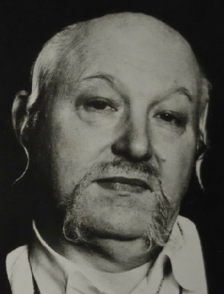 Wolf Vostell , born 1932 in Leverkusen – died 1998 in Berlin, was a German painter and sculptor, considered one of the early adopters of video art and installation art and pioneer of Happening and Fluxus. Techniques such as blurring and Dé-coll/age are characteristic for his work, as well as embedding objects in concrete or the use of television sets in his works.
Wolf Vostell , born 1932 in Leverkusen – died 1998 in Berlin, was a German painter and sculptor, considered one of the early adopters of video art and installation art and pioneer of Happening and Fluxus. Techniques such as blurring and Dé-coll/age are characteristic for his work, as well as embedding objects in concrete or the use of television sets in his works.
In 1953, he began an apprenticeship as a lithographer and studied at the Academy of Applied Art in Wuppertal. Vostell created his first Dé-collage in 1954. In 1955-1956, he studied at the École Nationale Superieur des Beaux Arts in Paris and in 1957 he attended the Düsseldorf Academy of Arts. Vostell’s philosophy was built around the idea that destruction is all around us and it runs through all of the twentieth century. He used the term Dé-coll/age in 1954 to refer to the process of tearing down posters, and for the use of mobile fragments of reality. Vostell’s working concept of décollage is about a visual force that breaks down outworn values and replaces them with thinking as a function distanced from media.
In 1958, he started his first European Happening in Paris – using first time television sets and cars. He was impressed by the work of Karlheinz Stockhausen, which he encountered in 1964 in the electronic studios of the German radio station WDR, and in 1959 he created his electronic TV Dé-coll/age. It marked the beginning of his dedication to the Fluxus Movement, which he co-founded in the early 1960s. Vostell was behind many Happenings worldwide. In 1962, he participated in the Festum Fluxorum, an international event in Wiesbaden together with Nam June Paik and George Maciunas. In 1963 Wolf Vostell became a pioneer of Video art and Installation with his work 6 TV Dé-coll/age shown at the Smolin Gallery in New York (now in the collection of the Museo Reina Sofía in Madrid). In 1967 his Happening Miss Vietnam dealt with the subject of the Vietnam war. In 1968, he founded Labor e.V., a group that was to investigate acoustic and visual events, together with Mauricio Kagel and others.
Wolf Vostell was the first artist in art history to integrate a television set into a work of art. This installation was created in 1958 under the title The black room, now part of the collection of the art museum Berlinische Galerie in Berlin. Early works with television sets are Transmigracion I-III from 1958 and Elektronischer Dé-coll/age Happening Raum, an installation from 1968. In 1974, his first major retrospective took place in the ARC 2 at the Musée d’Art Moderne de la Ville de Paris, an expanded version of which was shown at the Neue Nationalgalerie, in 1974.
Vostell’s automobile-concrete-sculptures made from cars and concrete are to be found in Cologne Ruhender Verkehr (Stationary traffic) from 1969, in Berlin Zwei Beton-Cadillacs in Form der nackten Maja (Concrete Cadillacs) from 1987 as well as VOAEX (Viaje de (H)ormigón por la Alta Extremadura) from 1976 in the Museo Vostell Malpartida in Malpartida de Cáceres, Spain and Concrete Traffic from 1970 in Chicago.
Vostell also gained recognition for his drawings and objects, such as images of American B-52 bombers, published under the rubric capitalist realism and as a result of his inclusion of television sets with his paintings. Nam June Paik and Vostell were both participants in the Fluxus movement and the work of both artists involved a critique of the fetishization of television and the culture of consumption. In 1992, the city of Cologne honoured Vostell with a major retrospective of his work. His works are exhibited i.a. at Stadtmuseum Köln, Kunsthalle Köln, Rheinisches Landesmuseum Bonn, Kunsthalle Mannheim, Schloss Morsbroich Leverkusen and Städtisches Museum Mülheim / Ruhr. His work is permanently exhibited at the Vostell Malpartida Museum Extremadura Spain. His son David Vostell created the documentary Vostell 60 – Rückblick 92. In 2018, in memory of twenty years after death, Art Thessaloniki artfair presented him as honoured artist.
